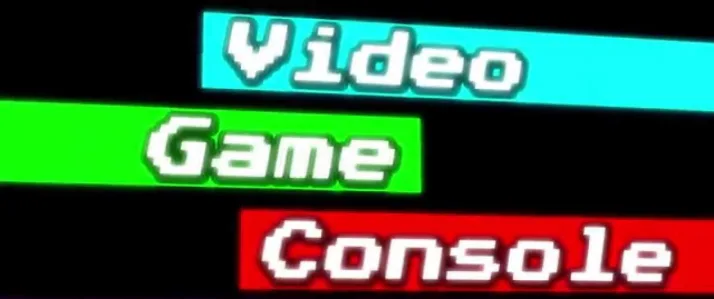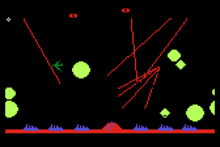Commercial
Summary
The Atari 5200 SuperSystem, commonly known as the Atari 5200, is a home video game console that was introduced in 1982 by Atari Inc. as a higher-end complementary console for the popular Atari 2600. The 5200 was created to compete with the Intellivision, but wound up more directly competing with the ColecoVision shortly after its release.
The 5200’s internal hardware is almost identical that of Atari’s 8-bit computers, although software is not directly compatible between the two systems. The 5200’s controllers have an analog joystick and a numeric keypad along with start, pause and reset buttons. The 360-degree non-centering joystick was touted as offering more control than the eight-way joystick controller offered with the Atari 2600.
History
The 5200’s large size is due in part to controller storage in the back of the unit.
Much of the technology in the Atari 8-bit family of home computer systems was originally developed as a second-generation games console intended to replace the 2600. However, as the system was reaching completion, the personal computer revolution was starting with the release of machines like the Commodore PET, TRS-80 and Apple II. These machines had less advanced hardware than the new Atari technology, but sold for much higher prices with associated higher profit margins. Atari’s management decided to enter this market, and the technology was repackaged into the Atari 400 and 800. The chipset used in these machines was created with the mindset that the 2600 would likely be obsolete by the 1980 time frame.
Atari later decided to re-enter the games market with a design that closely matched their original 1978 specifications. In its prototype stage, the Atari 5200 was originally called the “Atari Video System X – Advanced Video Computer System”, and was codenamed “Pam” after a female employee at Atari Inc. It is also rumored that PAM actually stood for “Personal Arcade Machine”, as the majority of games for the system ended up being arcade conversions. Actual working Atari Video System X machines, whose hardware is 100% identical to the Atari 5200 do exist, but are extremely rare.
The initial 1982 release of the system featured four controller ports, where nearly all other systems of the day had only one or two ports. The 5200 also featured a new style controller with an analog joystick, numeric keypad, two fire buttons on each side of the controller and game function keys for Start, Pause, and Reset. The 5200 also featured the innovation of the first automatic TV switchbox, allowing it to automatically switch from regular TV viewing to the game system signal when the system was activated. Previous RF adapters required the user to slide a switch on the adapter by hand. This unique RF box was also where the power supply connected in a unique dual power/television signal setup similar to the RCA Studio II’s. A single cable coming out of the 5200 plugged into the switch box and was used for both electricity and the television signal.
The 1983 revision of the Atari 5200 has two controller ports instead of four, and a change back to the more conventional separate power supply and standard non-autoswitching RF switch. It also has changes in the cartridge port address lines to allow for the Atari 2600 adapter released that year. While the adapter was only made to work on the two-port version, modifications can be made to the four-port to make it line-compatible. In fact, towards the end of the four-port model’s production run, there were a limited number of consoles produced which included these modifications. These consoles can be identified by an asterisk in their serial number.
Market performance
The Atari 5200 did not fare well commercially, compared to its predecessor, the Atari 2600. While it touted superior graphics to the 2600 and Mattel’s Intellivision, the system was initially incompatible with the 2600’s expansive library of games, and some market analysts have speculated that this hurt its sales, especially since an Atari 2600 cartridge adapter had been released for the Intellivision II. (A revised 2-port model was released in 1983, along with a game adapter that allowed gamers to play all 2600 games.) This lack of new games was due in part to a lack of funding, with Atari continuing to develop most of its games for the saturated 2600 market.
Many of the 5200’s games appeared simply as updated versions of 2600 titles, which failed to excite consumers. Its pack-in game, Super Breakout, was particularly criticized for not doing enough to demonstrate the system’s capabilities, and this gave the ColecoVision a significant advantage when its pack-in, Donkey Kong, delivered a more authentic arcade experience than any previous game cartridge. In its list of the top 25 game consoles of all time, IGN claimed that the main reason for the 5200’s market failure was the technological superiority of its competitor, while other sources maintain that the two consoles are roughly equivalent in power.
The 5200 received much criticism for the “sloppy” design of its non-centering analog controllers.
At one point following the 5200’s release, Atari had planned a smaller, cost-reduced version of the Atari 5200, which would have removed the controller storage bin. Code-named the “Atari 5100” (a.k.a. “Atari 5200 Jr.”), only a few fully working prototype 5100s were made before the project was canceled.
On May 21, 1984, during a press conference at which the Atari 7800 was introduced, company executives revealed that the 5200 had been discontinued after just two years on the market. Total sales of the 5200 were reportedly in excess of 1 million units.



